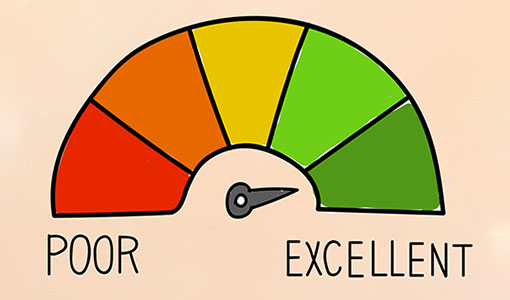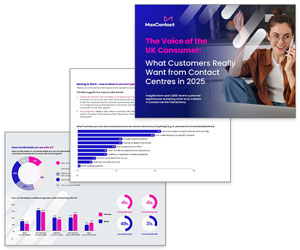Our panel of experts share examples of customer experience management tools and highlight how they can improve contact centre performance.
1. Knowledge Management Tools
Most businesses are looking to provide their customers with information to allow them to self-serve and fix their problem themselves. This information could be presented as frequently asked questions (FAQs), or in a self-diagnostic page on the company website.
Most contact centres opt for a knowledge base. This should be continuously improved and updated with feedback…
While you can look for different types of knowledge management tools, most contact centres opt for a knowledge base. This should be continuously improved and updated with feedback results from customers and advisors.
Businesses need to embrace the kind of questions customers are likely to use to search for answers to accelerate time to resolve – and use historic information from calls or search terms to populate these.
2. Voice of the Customer Tools
Businesses can use voice of customer (VoC) tools to collect customer feedback, and then analyse it using predictive business analytics to understand what similar customers tend to do in certain scenarios.
Collect customer feedback and then analyse it using predictive business analytics to understand what similar customers tend to do in certain scenarios…
At its simplest level, that could be a gas company receiving information that a customer is moving house, then predicting that the next interaction with that customer is likely to be around closing and opening meter readings, or a problem they have with a bill, for example.
Businesses could use this capability to better prepare for likely interactions and provide faster responses, or they could use it to be proactive and send the customer an email or text message to ask for a meter reading, for example.
3. Video Conferencing
Any customer-facing organization operating through the pandemic is challenged by the need to maintain high-quality customer service at a time when most people are working from home.
It is not easy to achieve. Video conferencing can be used to help customer-facing teams to work collaboratively and enable businesses to put a human face to what might otherwise be anonymous service.

Jeremy Payne
The best tools in this space provide a fully secure, private and high-end user experience across mobile, tablet and desktop.
These tools should also include easy-to-use meeting configuration and intuitive content sharing to further enhance service levels.
Thanks to Jeremy Payne at Enghouse Interactive
4. Speech Analytics
Trying to understand how the contact centre’s top advisors perform so well will no longer be a mystery, with the help of a speech analytics solution.

Tim Kimber
By finding this out, you can coach other advisors to adopt their methods quickly, giving the business the best chance of success.
Equally, the tool will identify any non-compliance, and you can take steps to resolve the issue quickly.
Knowledge gained from voice calls will integrate with CRM data. This will mean contact centres can identify customer experience improvement areas from the comfort of their CRM environment.
Thanks to Tim Kimber at Vonage
5. Omnichannel Routing
Routing is a fundamental part of a contact centre’s customer experience strategy.
With omnichannel routing, you can break down channel silos and gather valuable information from calls to deliver a more personalized and unified experience for your customers.
For example, we all know that customers get frustrated when they get passed onto multiple contact centre advisors and then must explain their issue several times.
With omnichannel routing, you can avoid issues such as these.

Daniel May
With this tool, your system will identify which advisor a customer spoke to last time, so that they can be routed to that same advisor each time, providing a more seamless customer experience.
As well as this, if a customer speaks to a specific advisor, they can also be routed to work with that advisor on other channels such as email or chat.
Thanks to Daniel May at Business Systems
6. CRM System
By its very definition, a CRM (Customer Relationship Management) system manages the relationship between your company and the customer. It’s an easy and effective way to ensure that each of your customers has a voice to be heard.
If you are using your CRMs to pull enormous amounts of data for an overall assessment or massive data points for campaigns, it’s important to understand that a CRM is capable of much more – in terms of improving customer experience.
It can be used to collect and maintain the minute details of individual customers, providing historical context to advisors…
For example, it can be used to collect and maintain the minute details of individual customers, providing historical context to advisors, in order to better inform their interactions with a customer.
With access to a snapshot of your customers, you can approach each customer experience touchpoint thoughtfully and efficiently, with the goal of obtaining actionable insights and improved customer satisfaction.
7. Social Monitoring Tools
Originally created to simply manage multiple social media platforms in one place, the value and functionality of these tools became evident soon after the increase of social media marketing budgets.
With most companies devoting an ever-increasing share of marketing focus and money to social media, it’s often the first experience customers have with your brand.
Not only are we managing social conversations, these tools now analyse and track the conversations, paying attention to trends.
Some things to watch using these tools include:

Chris O’Brien
- Hashtags (organic and user-generated, as well as associated hashtags)
- Your Paid Promoters and Influencers
- Misspellings
- Product mentions and usage
- Competitors
Thanks to Chris O’Brien at Aspect Software
8. KPI Reporting
You cannot manage what you cannot measure. Too many call centre managers lack adequate reporting to measure fundamentals like service level key performance indicators (KPIs).
Without basic KPI reporting, it becomes very difficult to benchmark key statistics…
Without basic KPI reporting, it becomes very difficult to benchmark key statistics, get a real-time understanding of what’s going on in the contact centre and understand what’s important for customers.
KPI reporting is therefore essential to delivering great customer experiences.
9. Sentiment Analysis
Sentiment analysis tools examine customer–advisor conversations and use linguistic analysis to determine a customer’s emotional state (e.g. happy, sad, frustrated, angry) and the cause (product, service, behaviour, etc.).

These tools enable you to track customer emotions across different contact reasons…
These tools enable you to track customer emotions across different contact reasons and spot customers that are at risk of churning.
Sentiment analysis can also be very effective when paired with quality management tools. Together, they can identify training or coaching needs and measure results.
10. Quality Management Tools
Contact centres are in a constant state of change and require continuous assessment of advisor skills.

Mark Ungerman
Quality management tools monitor interactions, evaluate competencies and can be used as a way of motivating advisors to keep on improving.
With these evaluations, managers can determine what training is needed and measure whether training objectives were met.
Thanks to Mark Ungerman at NICE inContact
11. Voice Biometrics
Passwords and PINs are a classic customer experience gripe. Many people forget at least one of their passwords every month and have to reset them or request for them to be resent.
By analysing unique voice and behavioural characteristics, biometric technologies are able to enhance security, without compromising on customer experience.

Brett Beranek
Customers don’t need to remember something specific and worry about it being stolen. There is no longer even a need to be authenticated using a specific passphrase such as “my voice is my password”.
Instead, biometric technologies are enabling organizations to validate a person’s identity through natural utterances, making for an easier customer experience.
Thanks to Brett Beranek at Nuance
12. Real-Time Speech Analytics
An exciting technology to emerge recently is real-time speech analytics (RTSA). The technology has been available for a few years, but we are only just seeing organizations start to use it in a purposeful way.
Once the necessary actions, changes and improvement initiatives have been identified through your customer experience management process and rolled out to advisors and team leaders, RTSA can sit across all interactions and can be configured to listen for those new elements.
Based on the presence (or absence) of those elements in the call, the tool can drive a workflow to display prompts on the advisor desktop.
For example, it can provide helpful reminders to advisors, such as:

Adam East
- “Don’t forget to ask…”
- “Don’t forget to say…”
- “Don’t forget to do…”
Using RTSA in this way, as a kind of virtual coach, will have a impact on the speed at which change is adopted within the operation and will accelerate your customer experience management cycles.
Thanks to Adam East at Noble Systems
13. Channel Shift
Most customers are happy to solve their enquiries on their own. However, human contact must always just be a tap, click or command away.

Ken Reid
Servicing multichannel customers doesn’t mean you have to stay on the channel they chose to contact you on. Use channel shift to meet them where they are and take them to where you want them to be.
The key thing to remember here is that, to exceed expectations, don’t operate your customer experience channels in silos.
Thanks to Ken Reid at Rostrvm Solutions
14. Artificial Intelligence Tools
Love it or hate it, artificial intelligence (AI) is here to stay. Robots, chatbots and virtual assistants, the latest AI tools, are designed to provide fast, efficient customer service without the need for human intervention.
Leveraging machine learning, they automatically screen customer data to develop tailored solutions along with the ability to solve simple customer interactions or turn negative conversations into positive ones.
The extra benefit of AI solutions is that the more they are used, the better they get…
The extra benefit of AI solutions is that the more they are used, the better they get, so make them an intrinsic part of your organization’s continuous improvement and customer experience strategies.
A word of caution – just because everyone is talking about AI, don’t let FOMO or a “fear of missing out” cloud your judgement. Don’t rush in, and avoid a scatter-gun approach – why break all the eggs to make one single omelette?
Pragmatism is the name of the game. Look for easy, low-cost, low-risk ways to demonstrate several quick wins that inspire customer and board-level confidence and go from there.
15. Predictive Analysis
Another way analytics can enhance customer experience management is to make a customer’s journey smoother by alleviating contact centre pain points and anticipating a customer’s future needs.
For example, by turning basic data into valuable and actionable customer experience intelligence, organizations could consider machine learning to improve their net promoter score (NPS).

Magnus Geverts
Turn customer experience management theory into practice using predictive analytics. These tools analyse the positive/negative/neutral sentiment of customer interactions, valuable intelligence that contact centres can use to pre-empt and predict future patterns and outcomes.
So, if 75 people out of 123 scored 10/10, rather than hope for the best, managers could simply use the results of machine learning to introduce different ways of working that are guaranteed to satisfy the other 48 customers. Simple but effective.
Thanks to Magnus Geverts at Calabrio
16. Softphones
A softphone allows an advisor to phone customers from a general-purpose computer, meaning that the contact centre doesn’t have to invest in specialized communications hardware.

Richard Kenny
Cloud softphones help contact centres to keep pace with the rapid deployment of new features and are great for homeworking, as advisors can use their own laptops.
Only by using a cloud-based device management tool can your IT team continue to ensure that all remote workers get an easy experience working between their devices and softphones.
Thanks to Richard Kenny at Poly
17. Customer Self-Service
By offering customers an intuitive self-service option that responds and adapts quickly to their changing needs, businesses can provide their clients with a more personalized customer experience.
Using built-in reporting to achieve full visibility into how their consumers move through their self-service journeys, they can then optimize their offering and boost the customer experience, also netting significant savings for the organization.
This approach allows companies to offer continual customer experience enhancements that help increase and maintain loyalty.

Brendan Dykes
Most importantly, self-service solutions can keep the context of each individual interaction intact to ensure that businesses are there when their customers need them.
By logging each interaction and building a complete customer history, this ensures advisors are able to seamlessly pick up with customers at any point in their journey.
Thanks to Brendan Dykes at Genesys
18. Journey Mapping Software
Most companies just can’t understand their customers’ full experience because they don’t have the tools to allow them to view all interactions in one place.
If you use technology that can analyse all customer interactions, across every channel, using a single analytics platform, you can identify customer expectations on response times and channel preferences.
With this journey mapping software, you will understand why people use each channel…
With this journey mapping software, you will understand why people use each channel. You can then provide the right resources to meet those needs.
In addition to this, you can also point them in the right direction to use the right channel at the right time.
19. Automated Quality Scoring
With tools that capture every part of the conversation – not just the keyword recognition that most traditional quality systems have – the result is a wealth of actionable information presented in a user-friendly dashboard with configurable scorecard metrics.
Resulting quality metrics enable contact centres to identify exactly where advisors need help and continuously measure progress across KPIs.

Quality metrics enable contact centres to identify exactly where advisors need help and continuously measure progress…
Utilizing pre-built and customized language categories, such as repeat contact, dissatisfaction, empathy, understandability and other behavioural language, can help uncover mishandled or unresolved issues.
With this data on all interactions, contact centres can further advance their level of understanding of root cause analysis on both first call resolution successes and failures.
Solving customers’ needs quickly and in the first contact not only reduces costs but is the major contributor to customer satisfaction from contact centre interaction.
20. Real-Time Coaching Tools
Advisors will have to deal with customers who arrive in a negative frame of mind.
Perhaps surprisingly, this can, however, lead to a good customer experience – but only if the customer is handled in a way that exceeds their expectations.
Alternatively, a call may start well but deteriorate if not managed well by the advisor, causing the customer to leave dissatisfied.

Frank Sherlock
Deploying interaction analytics real-time coaching and alerting tools in a contact centre provides advisors with the information they need in an easy and timely manner.
It enables them to resolve customer queries and adjust their behaviour during the call to deliver a successful outcome and leave the customer satisfied.
Thanks to Frank Sherlock at CallMiner
For more from our panel of experts, read our articles:
- The Top 10 Emerging Technologies in Contact Centres
- 18 Ways to Improve the Effectiveness of Your Digital Customer Service
- Which Technologies Give the Best Return on Investment (ROI)?
Author: Robyn Coppell
Published On: 20th Jul 2020 - Last modified: 10th Jan 2025
Read more about - Technology, Alvaria, Brendan Dykes, Brett Beranek, Business Systems, Calabrio, CallMiner, Customer Experience Management (CEM), CX, Enghouse Interactive, Genesys, Jeremy Payne, Ken Reid, Magnus Geverts, NICE CXone, Noble Systems, Nuance, Poly, Richard Kenny, Rostrvm, Tim Kimber, Vonage





















